#box jellyfish
Text
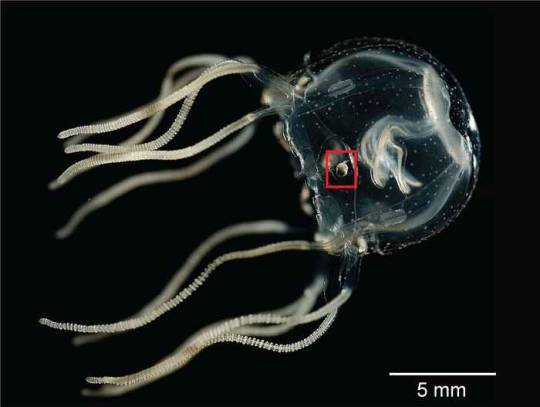
BRAINLESS BOX JELLIES CAN LEARN BY EXPERIENCE
Mangrove box jellyfish (Tripedalia cystophora) is a small species of box jellyfish, native to the Caribbean Sea and the Central Indo-Pacific, presenting a simple nervous system. But despite tiny, researchers have demonstrated present the ability to learn by association. Although has no central brain, and being the size of the finger-tip, this box jelly can be trained to associate the sensation of bumping into something with a visual cue, and to use the information to avoid future collisions.
In the wild, the Mangrove box jellyfish forage for tiny crustaceans between the roots of mangroves. To mimic this environment, researchers placed the box jellies in cylindrical tanks that had either black and white or grey and white vertical stripes on the walls. To the jellyfish, the dark stripes looked like mangrove roots in either clear or murky water. In the ‘murky water’ tanks, the jellyfish bumped into the wall because their visual system couldn’t detect the grey stripes very clearly. But after a few minutes, they learnt to adjust their behaviour, pulsing rapidly to swim away from the wall when they got too close, this state learning is based on the combination of visual and mechanical stimuli in simple animals with no brain.
The learning process, in difference with vertebrate animals, doesnt occurs in a central neuronal organs, but instead in a small organs named rhopalial nervous system, which act as learning center, in which the jelly combines visual and mechanical stimuli during operant conditioning.
Main image: An adult specimen of the box jellyfish T. cystophora., showing where is located one of the four sensory structures named rhopalia, which includes two lens eyes. Each rhopalium also contains a visual information processing center.
Reference (Open Access): Bielecki et al., 2023. Associative learning in the box jellyfish Tripedalia cystophora. Current Biology.
#Tripedalia cystophora#box jellyfish#cnidaria#marine science#marine biology#biology#science#sciblr#scienceblr#zoology#behavior#bioblr#biologyblr
444 notes
·
View notes
Text
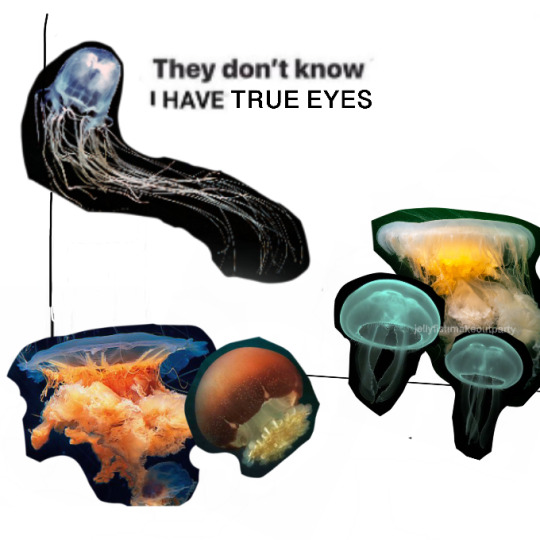
a post for all of my fellow jelly enthusiasts
#box jellyfish#basically box jellies r jellies that have ‘true eyes’ or a more complete visual system!!#other jellies + cnidarians have light-detecting organs#but box jellies have more complete visual systems!’#4 clusters of 6 eyes I think!! 24 in total#<— for those who don’t know/wanna know more!#correct me if I’m wrong#sea wasp#jellyfish#jellies#cnidarians#Cnidaria#invertebrate#marine bio#marine biology#marine biology memes#biology#science#ocean lovers#ocean#sea#marine science#fixation#neurodivergent#bio#moon jellyfish#eggyolk jellyfish#lion’s mane jellyfish#post#long tags sorry
2K notes
·
View notes
Text

Sea wasp
By: K. Gillett
From: The Fascinating Secrets of Oceans & Islands
1972
#box jellyfish#cnidarian#invertebrate#1972#1970s#K. Gillett#The Fascinating Secrets of Oceans & Islands
235 notes
·
View notes
Text
🫧Daily Marine Fact🫧:
🪼Box Jellyfish have 24 eyes. Their eyes are more similar to vertebrates and their visual system is elaborate. They have a pair of pit eyes, a pair of slit eyes, a small upper lens eye, and a larger lower lens eye🪼
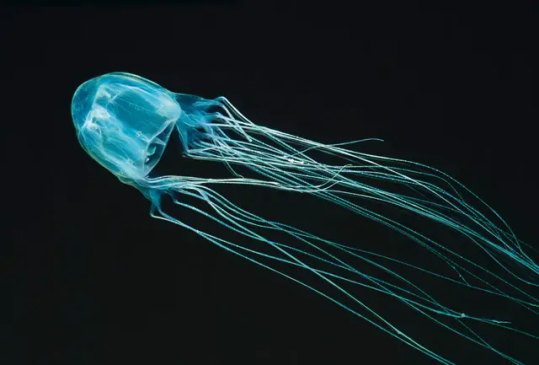
#marine bio#marine biodiversity#marine biology#marine life#marine facts#daily marine fact#box jellyfish#jellyfish
127 notes
·
View notes
Text

Truly terrifying!
#i have officially accepted my uni offer!#marine biology#marine biology shitpost#marine animals#box jellyfish#i wish i had developped a tagging system two years ago but im too lazy to go back through every single post and change the tags
379 notes
·
View notes
Text
Yeah I know this poll is a little apex predator heavy, but to be frank, most sea creatures (living and extinct) would amount to nothing more than fish/whale/ichthyosaur/shark, etc. fodder and that would not make for a fun poll.
#poll#wet beast wednesday#fish#crabs#cephalopods#sharks#marine reptiles#sea turtle#jellyfish#box jellyfish#extinct species#prehistoric life#mosasaurus#ichtyosaurs#whales#cetaceans#dolphin#marine life#marine biology
136 notes
·
View notes
Text

Researchers named the newfound species Tripedalia maipoensis, after Mai Po Nature Reserve in Hong Kong, where they discovered the transparent critter
Like other box jellyfish, the newfound species has 24 eyes arranged in clusters of six around its cubic body.
(Image credit: Hong Kong Baptist University (screenshot from hongkongbaptistu on YouTube))
#hong kong baptist university#photographer#youtube#tripedalia maipoensis#box jellyfish#jellyfish#marine#mai po nature reserve#hong kong#nature
60 notes
·
View notes
Text

stygiomedusa gigantea my beloved 🪼 she’s a biblical angel to me
please don’t repost, but okay to rb
#my art#art#img#drawing#jellyfish#stygiomedusa gigantea#lions mane jelly#moon jellyfish#box jellyfish#finished
52 notes
·
View notes
Text
Taxonomy Tournament: Cnidarians
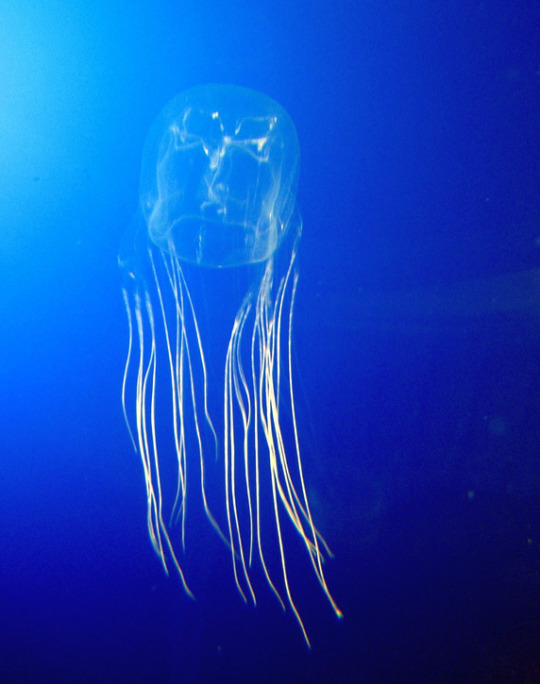

Cubozoa. This class is known as the box jellyfish, which have a cube-shaped bell which allows it to move faster than other jellyfish
Hydrozoa. This class is of predatory cnidarians, some of which are colonial, include hydras and the Portuguese Man o' War
#animals#biology#polls#poll tournament#zoology#jellyfish#box jellyfish#cnidarians#hydras#portuguese man o'war#Cubozoa#Hydrozoa#0x75v0x8a#animal tournament#Animal Tournament Round 1
41 notes
·
View notes
Note
favorite cnidarian? theyre ma favorite phylum so id love to hear your favorite. or whichever you feel like talking about. also, sorry for reblogging a ton from you. big fan of the random marine facts.
Aaaaaa this is so hard. The phylum Cnidarian includes organisms like jellyfish, anemones, hydras, corals, and hydrozoa.
My favorite class is definitely Scyphozoa which is the free swimming true jellyfish. What interests me most about jellyfish is their nematocysts (stinging cells), so if I had to pick, I suppose I would pick the most deadly one- the Box Jellyfish.
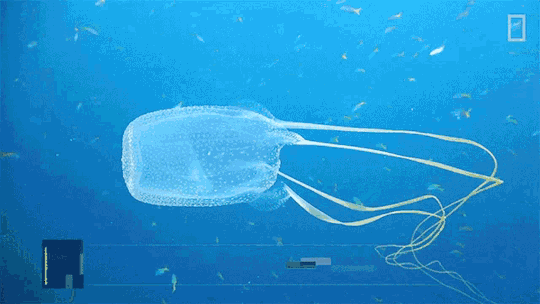
Cubazoa or Box Jellyfish are (as the gif says) the most venomous marine animal (that we know of). Like other jellyfish, they deliver their potent venom via nematocysts. Nematocysts are touch sensitive, when an organism brushes agains the tentacles, a stored thread with a barbed bob are released. These latch onto the organism and release toxin.

What makes the Box Jellyfish venom so deadly is that it contains toxins that attack the heart, nervous system, as well as skin. It's so potent that people have been known to suffer heart failure or go into shock and drown before they reach the shore.
Thanks for the ask!
#jellyfish#marine biology#marine ecology#animals#box jellyfish#science#animal facts#biology#nature#wildlife#sea animals#sea creatures#sea animal#marine life#ocean#sea#oceans#wilderness#biodiversity#ecology#deadly animals#deadly animals in australia#cnidarian#cnidarians
471 notes
·
View notes
Text

Inktober Day 25, Dangerous
Box jellyfish 😱
36 notes
·
View notes
Link
New jellyfish found in hong kong - Tripedalia maipoensis
The first box jellyfish species to be discovered in Chinese waters
(source: miami herald | 18 apr 2023)
#box jellyfish#maipo#mai po nature reserve#Tripedalia maipoensis#first box jellyfish in chinese waters#hong kong baptist university#hong kong biodiversity
91 notes
·
View notes
Text
Sooo... jellyfish.
You may have seen this video circulating recently. The original was posted on Facebook by Scuba Ventures Kavieng; this is a colour-corrected edit [link to the original in the post source, because Tumblr is stupid about external links]. It caused a small stir on the internet after being tentatively identified as Chirodectes maculatus, a monotypic genus known only from a single small specimen captured and filmed in 1997, off the coast of Queensland. (That footage is sadly not available on the Internet.)
If you know a little about jellies, you’ll recognise this as a box jellyfish or Cubozoan. Box jellies are wonderfully interesting animals, and differ from the more familiar “true jellyfish” or Scyphozoa in a number of ways:
a more developed nervous system allowing more complex behaviour, including the capacity to learn from experience
true eyes (with retinas, corneas, lenses, the whole shebang)
the ability, unlike true jellies which mostly drift, to actively propel themselves around obstacles and towards prey
...a concerning trait in an animal most notorious for being extremely fatal to humans. (c.f. Wasp Jellyfish, Viper Jellyfish, the delightfully named Common Kingslayer, Irukandji*) * sting symptoms include excruciating pain and “a feeling of impending doom”, and let’s raise a glass to the researcher who first documented Irukandji syndrome by deliberately testing it on himself, a lifeguard, and his nine-year old son: “Eschewing animal models and laboratory studies (not to mention all common sense), Barnes took the two specimens, and proceeded directly to human experimentation.” please read the article linked in my reblog, it’s hilarious. (A lack of self-preservation is a trait apparently common to all jellyfish scientists - the 2005 article on Chirodectes maculatus notes that it failed to sting, or adhere to, the hand and forearm of an incautious volunteer.)
The point is that box jellies are deeply, deeply cool in every respect except basic body plan, which goeth thusly:
box
tentacle on each of the four lower corners
....and while many cubozoans find that four is not enough and multiply to get 4n tentacles, that’s about it. Ultimately, what you end up with is still just a translucent jelly box with string hanging from each corner, like a very sad, very dangerous piñata.
Compare scyphozoans / "true jellies":
[top to bottom: Pacific sea nettles Chrysaora fuscescens aka windows screensaver, barrel jellyfish Rhizostoma pulmo, sea cauliflower Cephea cephea, moon jelly Aurelia aurita, lion's mane jellyfish Cyanea capillata]
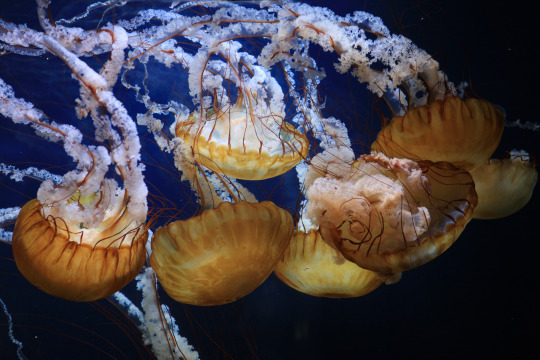
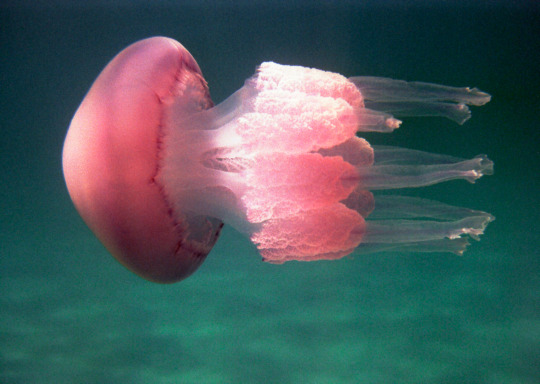

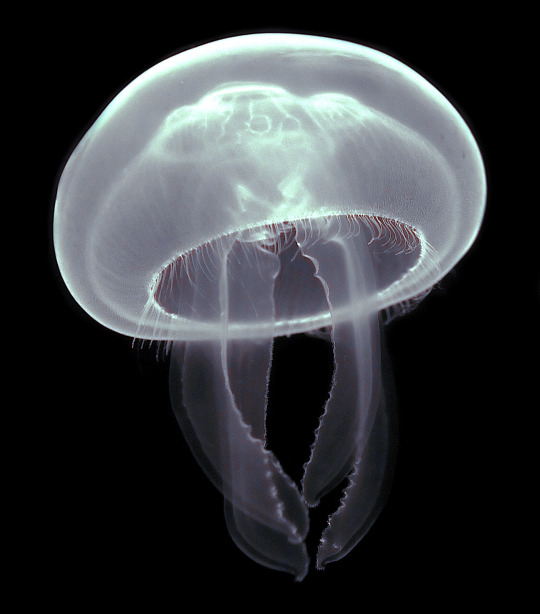

They may not be all that bright, but by god they’re fancy.
Now let's see the box jellies: [Bonaire banded box jellyfish, which rejoices in the name of Tamoya ohboya; sea wasp Chironex fleckeri; Copula sivickisi; Tripedalia cystophora]

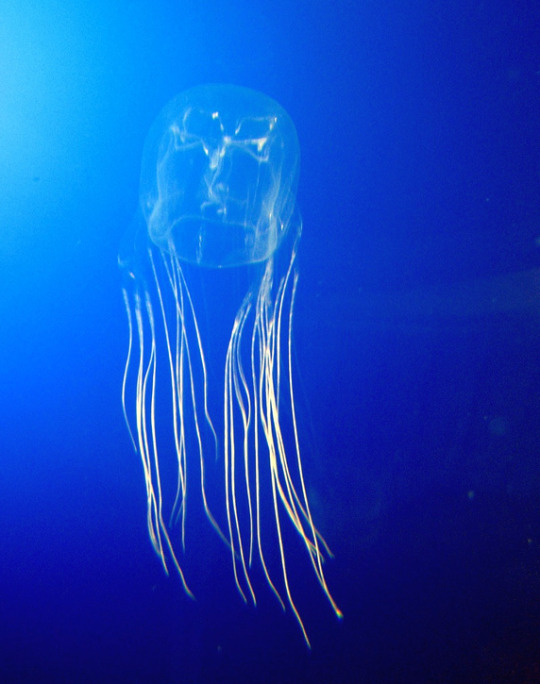
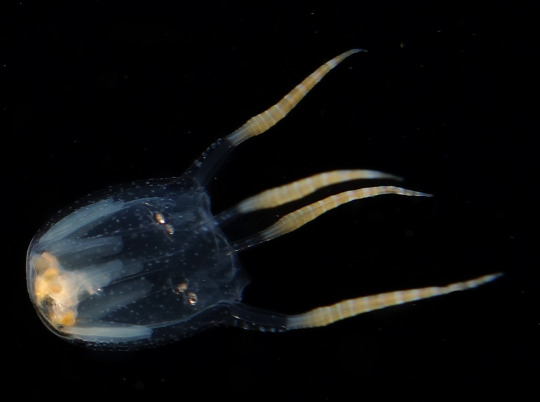

And by cubozoan standards, it is big: according to the diver, "a bit bigger than a soccer ball" (which have a ~21cm diameter), which would make it larger than the 15cm in the original species description.
Where am I going with all this? My point, dear jelly lovers, is that Chirodectes maculatus took a body plan like an inverted plastic bag and made it into the fanciest, most ostentatious chunk of jelly that ever wobbled the seven seas.
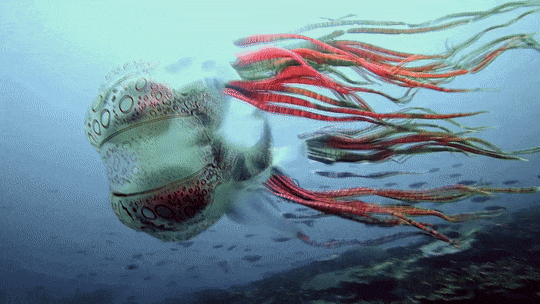
Look at it. It’s like a 1970s lampshade set off to colonise the ocean. And isn't it just fabulous.
Please reblog the linked post for sources and further reading. All images via Wikimedia Commons (licensed with some version of Creative Commons.)
#you may not like it but this is what peak adaptation looks like#there are many benefits to being a marine biologist#being stung by box jellies is not one of them#marine biology#jellyfish#box jellyfish#nature writing#cubozoa#my writings#science!#video
359 notes
·
View notes
Text
Day 18 of @fish-daily's Fish-uary: Pacific Ocean. I drew box jellyfish

[Image ID: translucent white jellyfish floating through deep blue water. End ID]
#jellyfish#box jellyfish#pacific ocean#sea creatures#fish#fishuary#fishuary2024#image id#artist described#art
9 notes
·
View notes
Text

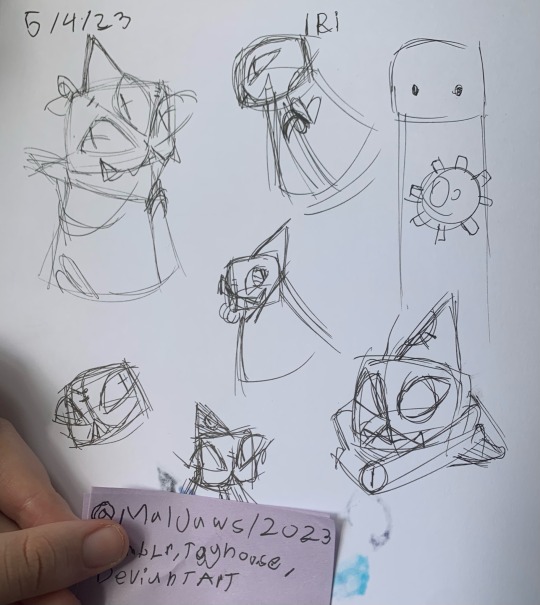




Concept art of my COTL oc, Mahlon! Probably first of many
He’s a box jellyfish, head priest under Kalamar (albeit, second to a god is a cliff of difference) and local dumbass
Still work in progress! I may make a pt 2 on the final
#concept art#art#cult of the lamb#maljaws#maljaws art#maljaws content#cotl#cotl oc#jellyfish#jellyfish anthro#box jellyfish#Mahlon COTL Oc
34 notes
·
View notes
Text

I am so sorry for fucking dying. Here is art for you people. I will draw Terraria fanart at some point.
#jellyfish#box jellyfish#ocean#sea creatures#sea#gijinka#humanization#ocean creatures#tw needles#art#scubaposting#character design#blue
9 notes
·
View notes